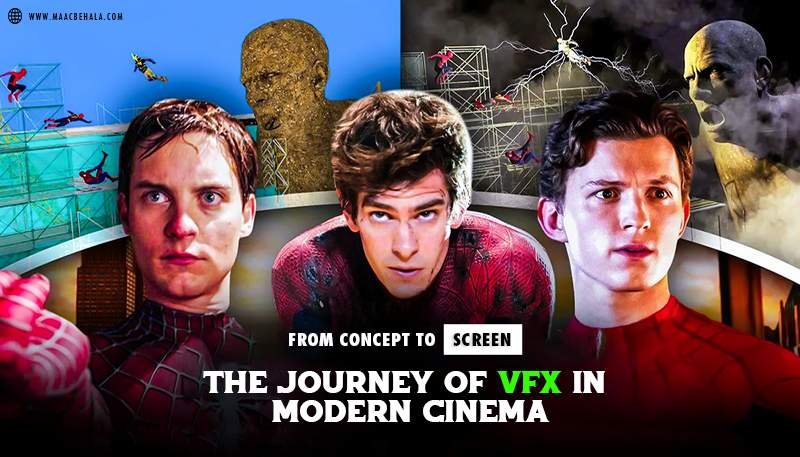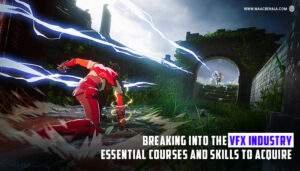Introduction:
The world of cinema is not limited to storytelling anymore. The film industry is exploring the tools and software of animation and VFX that create a realm of reality. VFX plays a significant role in promoting the film industry by showcasing some of the magical scenes to life in the silver screen. A good movie requires a lot of hard work, dedication, technology, planning, and creativity with proper implementation of visual effects. If you are a big-time movie lover and passionate about filmmaking from the first to the final stage, enroll in the VFX course in Kolkata from MAAC Behala and obtain the certificate to become a prominent VFX artist and enhance your career in the future. In this blog, we will be exploring the journey of VFX in modern cinema that starts from the traditional to the modern generation to create history.
The history of VFX:
The history of visual effects in the film industry is an innovative journey with the help of technology, creativity, and storytelling. It all began in the late 19th and 20th centuries with the starting of movies like Le Voyage dans la Lune (1902). However, with the growing technology and evolution of the software, VFX become the leader and dominates the film industry. A good movie is impossible without the effects of VFX.
Join the VFX course to become part of this glorious film industry that helps create the best movies.
The Artist and Technician of VFX:
The artist and technician create a vision of a movie. Their skills help in creating the best movie scene that creates magic. Check out the role of the artist and technician of movies:
- VFX Artist: It is also known as a visual effects artist who individually works with the process of CGI and 3D modeling to create the best visual stunt. They are expert in creating some of the giant characters like monsters and breathtaking scenarios.
- Special Effects Team: These teams are responsible for building, installing, or operating the equipment that is needed to create scripts for television and silver screen. Their experts read the script before filming and determine how to implement the best visual effects.
- Directors: A director is responsible for any final movie scene and film narration from start to end. They collaborate with the visual effects team to narrate the film with magical moments. To get the best experience in VFX filmmaking, join MAAC Behala top VFX institute in Kolkata that develops the skills of the learners to create the top artists.
How to become a successful VFX artist?
The film industry is a dynamic and exciting field where VFX (Visual Effects) artists play a crucial role in bringing stories to life. If you aspire to become a successful VFX artist, here’s a comprehensive guide to help you achieve your goal.
1. Get Educated in VFX and Related Fields
Formal Education:
- Certification: Many VFX artists have a certification in animation, graphic design, VFX, or a related field. This provides a solid foundation in the principles of art and design, as well as technical skills.
- Specialized Courses: Enroll in specialized VFX courses offered by institutes like MAAC, which provide in-depth training in VFX software and techniques.
Online Learning:
- Tutorials and Courses: Platforms like MAAC offers VFX courses that can help you learn at your own pace.
- YouTube Tutorials: Many VFX professionals share tips and tutorials on YouTube, which can be a valuable resource for learning new skills.
2. Master VFX Software and Tools
Industry-Standard Software:
- Adobe After Effects: Essential for compositing and motion graphics.
- Autodesk Maya: Widely used for 3D modeling, animation, and simulation.
- Nuke: A powerful compositing software used for film and television.
- Houdini: Known for its advanced simulation capabilities in particles, fluids, and other dynamic effects.
- Cinema 4D: Popular for motion graphics and 3D modeling.
Continuous Learning:
- Stay updated with the latest software updates and new tools in the industry.
- Participate in forums and communities to learn from other VFX artists.
3. Develop a Strong Portfolio
Showcase Your Best Work:
- Diverse Projects: Include a variety of projects that demonstrate your range of skills, such as 3D modeling, compositing, motion graphics, and simulations.
- Breakdown Videos: Show the progression of your work from initial concept to final product. This helps potential employers understand your workflow and problem-solving abilities.
- High-Quality Visuals: Ensure that your portfolio pieces are polished and of high quality. Attention to detail is crucial in the VFX industry.
Create a Demo Reel:
- A short, 1-2 minute video that highlights your best work.
- Keep it concise and engaging, showcasing only your strongest pieces.
4. Gain Industry Experience
Internships and Entry-Level Positions:
- Internships: Many VFX studios offer internships that provide hands-on experience and industry connections.
- Junior Positions: Start with entry-level roles such as junior compositor, 3D artist, or production assistant to gain practical experience.
Freelance Projects:
- Build Experience: Take on freelance projects to build your portfolio and gain real-world experience.
- Networking: Freelancing can help you network with industry professionals and open doors to future opportunities.
5. Stay Updated with Industry Trends
Attend Industry Events:
- Conferences and Expos: Events like SIGGRAPH, NAB Show, and GDC offer opportunities to learn about the latest trends and technologies in VFX.
- Workshops and Webinars: Participate in different workshops to sharpen your skills and conducted by industry experts.
Follow Industry News:
- Blogs and Websites: Stay informed by following VFX-related blogs, websites, and forums.
- Social Media: Join VFX groups on platforms like LinkedIn, Facebook, and Reddit to stay connected with the community.
6. Network with Industry Professionals
Join Professional Associations:
- Organizations like the Visual Effects Society (VES) offer networking opportunities, industry insights, and career development resources.
Online Networking:
- LinkedIn: Connect with experts in the industry, join relevant groups, and participate in discussions.
- VFX Forums: Engage in discussions on forums like CGSociety, ArtStation, and others.
7. Cultivate Soft Skills
Communication:
- Clear communication is essential for collaborating with directors, producers, and other team members.
Problem-Solving:
- The ability to troubleshoot and find creative solutions to technical challenges is highly valued in the VFX industry.
Time Management:
- Working on tight deadlines requires excellent time management and organizational skills.
8. Seek Feedback and Improve
Constructive Criticism:
- Take feedback from peers and mentors to identify areas for weakness.
- Be open to constructive problems and use them to enhance your skills.
Continuous Improvement:
- Regularly review and update your portfolio to reflect your latest and best work.
- Keep learning and improving your skills to stay competitive in the industry.
Conclusion:
Becoming a successful VFX artist in the film industry requires a combination of technical skills, creativity, and perseverance from the best VFX coaching in Kolkata. By following these steps like, continuously learning, and staying connected with the industry, you can build a rewarding career in VFX. The Journey of VFX in Modern Cinema may be challenging but with dedication and passion, you can achieve your dream of becoming a successful VFX artist.




